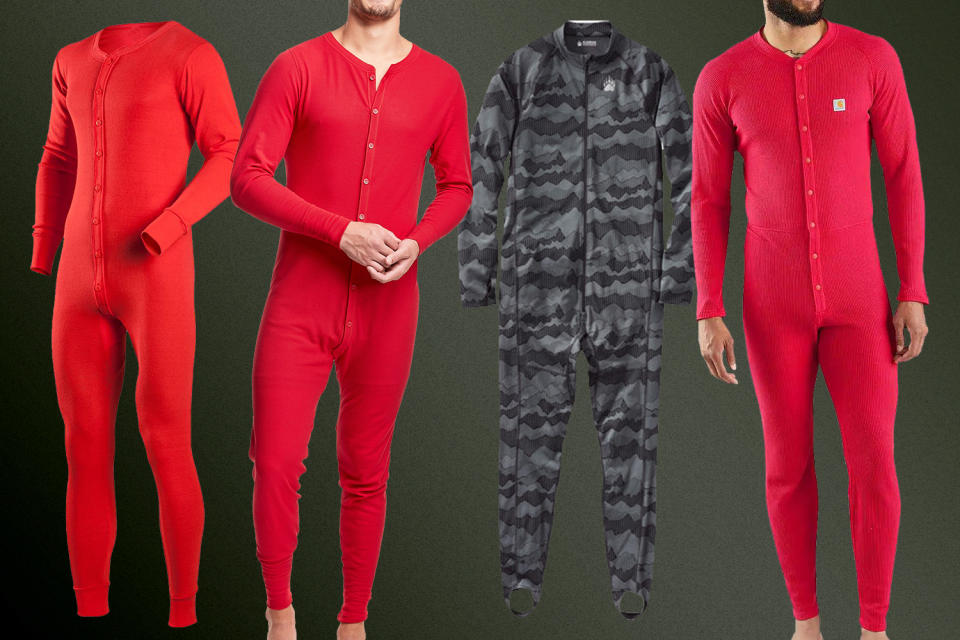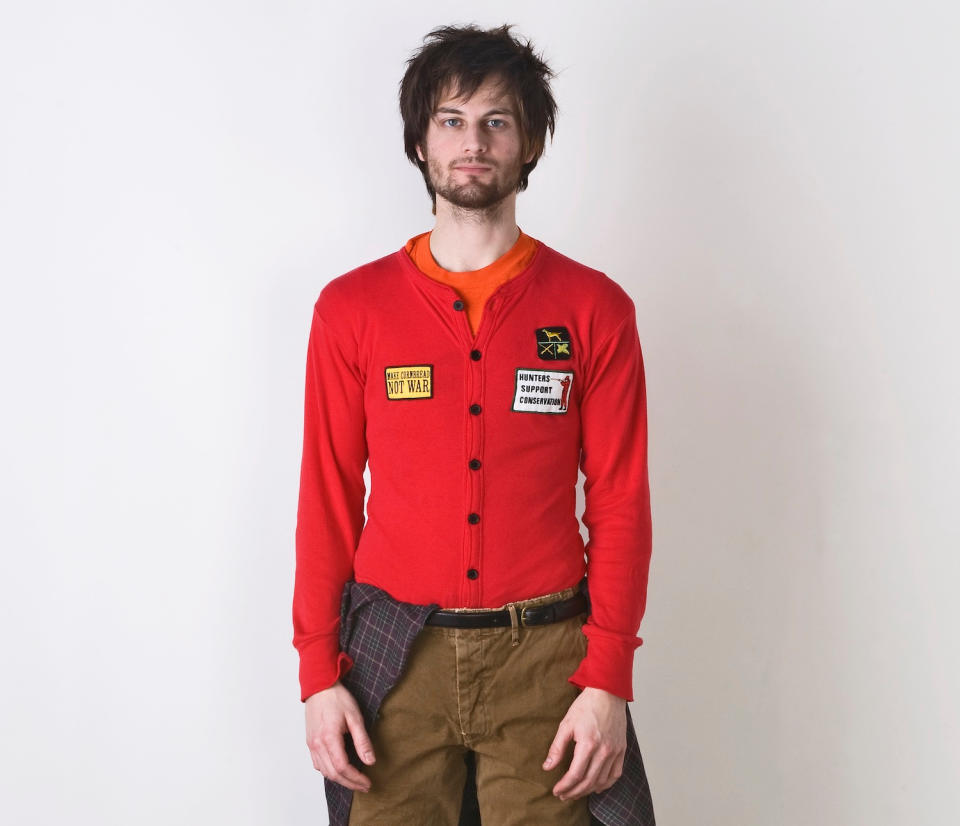If I say the word “prospector,” what comes to mind? You’re likely picturing a grizzled old-timer seeking his gold-rush fortune with a pickaxe and wide-brim hat, maybe even missing a couple of teeth. But there’s another piece of clothing that every caricature of the character includes: a pair of one-piece long johns, probably in bright red, with a butt flap.
Everyone knows this garment, but there’s a good chance you don’t know the name. It’s called the union suit. In the depths of winter, there’s nothing better — and nothing quite like it. When you want to stay underneath your flannel sheets or wish the flannel lining in your pants extended through the rest of your clothes, the union suit is there, offering uninterrupted warmth from wrist to neck to ankle. And when necessity forces you to disrobe, fear not, there’s a button fly in the front and a butt flap in the rear.
It’s that flap — also known as the access hatch, drop hatch, drop seat, fireman’s flap and a number of other less couth monikers — that’s partly why the union suit has become one of the most unfairly maligned pieces of cold-weather gear in history. As it turns out, the garment is also one of the most misunderstood, as modern society has generally forgotten that its origins aren’t tied up with cliché masculine archetypes like the prospector, but revolutionary women in the reform movement.
“The first union suit was patented in 1868,” explains Susan Marks in an email, “although versions of it had been around for decades beforehand.” She’s the author of a book on Munsingwear, an underwear company who for decades was the largest producer of union suits in the U.S. That patent wasn’t for a hearty piece of menswear for working out of doors, it was for the “emancipation union under flannel,” which as an article at Ohio State University notes was “one of the first reform undergarments to be promoted in America.” In other words, it was for women. It was a knit flannel shirt and pants in one, an undergarment that stood in the face of the tight corsets and extra bulk then required by societal standards.
However, while that specific patent offers one clue to the genesis of the “union suit” name — two separate pieces, a top and bottom, joined into a more perfect union — Marks cautions against relying on that alone in writing the history of the garment. Historians are not in agreement on the etymology, and she cites a couple other possibilities where the name could originate from, including the Union Army and potentially an older brand.
“The lack of documentation has a lot to do with ‘talking about unmentionables’ being a taboo subject and not deemed worthy enough to keep and save records about it for a century or so,” she explains.
Munsingwear, originally called Northwestern Knitting Company, was instrumental in chipping away at the taboo, both because the company’s proprietary technology led to increased adoption of the style (instead of relying on the traditional itchy wool and flannel, they produced silk-plated union suits) and because they produced ads that made the general public more comfortable talking about underwear (by using real models instead of illustrations).
Eventually, changing fashion mores pushed the union suit to the realm we associate it with today — colder climes, rural areas, and places where warmth and utility still take precedence over style. As for Munsingwear, the reason that name might ring a bell is because the company lives on in an unexpected locale: under Perry Ellis, in the Original Penguin brand. Munsingwear introduced golf shirts with a penguin logo in the ‘50s, and that business eventually outgrew the underwear and union suits.
If you look closely under the current Original Penguin logo you can see the proof: “By Munsingwear.”
Unfortunately you can’t buy a Penguin union suit today (though the combination of that logo and the intended use in sub-zero temperatures makes me think that wouldn’t be a bad idea for a heritage capsule collection), but there are a number of outfitters that still produce them, many in the iconic red hue, including Carhartt, Hanes and Indera Mills, a century-old thermal underwear manufacturer in North Carolina. Duluth Trading’s sub-brand Alaskan Hardgear makes one of the few modern styles, though it will put you out over $100. Among the best is L.L.Bean’s superb ode to the original, but as such, their union suit is already sold out for the season — though they’ve assured me it’ll be restocked in the late summer.
Designer Billy Reid ran into a similar situation as L.L.Bean when he introduced his own union suit back in 2008. He was digging through deadstock at a general store in Florence, Alabama, when he came across a box of red union suits. He bought them all and took them into his studio, manipulated them, put patches on them and finally decided to pepper them into his runway show.
“We had it in the press collection, and it was one of those weird things where people dug it,” Reid said on a recent phone call. The fashion community latched onto it — whether for its sheer novelty, a sign of the folksy zeitgeist of the time (a year later, the first Mumford & Sons album was released and Best Made Co. was founded), or the subverted expectations of something thought to be purely utilitarian — so Reid decided to manufacture some of his own for sale.
They did it authentically, with a butt flap, full fly, cherry red color (alongside a natural option, and a grey heather for women), all made in a U.S. factory. “I think we made runs of like 48 pieces, but we had to remake it a couple of times,” he says. “It was a popular item.”
“What was weird about it — for some reason, I don’t know why, you think of the South when you think of these things — but the best-selling store was New York,” Reid adds. “They’re the ones who bought most of it out. I don’t know who bought them. I wish I had the customer profile on who bought the union suit.”
While he doesn’t have that specific profile, Reid is intimately familiar with the kind of person who would want one-piece long underwear — himself, for example. He owns a number of them and breaks them out for hunting and camping trips. He also recalls his friend Butch Anthony, an artist, wearing one for three days straight while working on an in-store installation in 90-degree heat, as well as his grandfather owning “a closet of nothing but jumpsuits,” union suits included.
Billy Reid, the brand, stopped selling union suits after about three seasons, mainly because the domestic factory where they were produced went out of business, and not many other apparel companies want to make them. As he explains, “It’s kind of a pain in the butt to make the piece.”
Despite the hassle of the construction, the outdated styling and the limited options on the market, he doesn’t think the union suit will ever disappear for good. By design, he says, it’s the perfect base layer for any situation, whether that’s going off in the wilderness to seek your fortune or holing up in your house during the winter months while riding out a global pandemic.
More Like This
The post The History of the Union Suit, the Infamous Butt-Flap Long Johns appeared first on InsideHook.
The article The History of the Union Suit, the Infamous Butt-Flap Long Johns by Alex Lauer was originally published on InsideHook.

